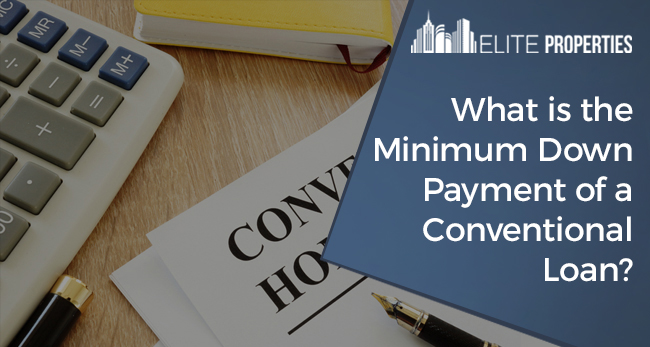The most common kind of loan utilized to purchase a home is a conventional loan. With a good credit score and a substantial minimum down payment, a conventional loan can be a good fit for you. But how much money do you need for a conventional loan’s minimum down payment?
- A conventional loan’s minimal down payment is determined by numerous factors, including the sales price and the borrower’s credentials.
- A conventional loan’s minimal down payment might be as low as 3% of the purchase price.
- Borrowers who want to avoid paying private mortgage insurance should budget for a down payment of at least 20% of the purchase price.
What is a conventional loan?
Mortgages that are not insured or backed by government organizations are referred to as conventional loans. They’re offered and guaranteed by private lenders, and while most follow government norms and regulations, they’re not issued or backed by the government. “Conforming loans” are those that adhere to government norms and regulations.
Private mortgage insurance (PMI) is normally required on conventional loans if the down payment is less than 20% of the purchase price.
Private mortgage insurance is a monthly charge that is added to your mortgage payment. It protects the lender if you default on your mortgage payments.
Conventional Loan Down-Payment Requirements
Although a minimum down payment of 20% is frequently recommended, it is not required. Depending on your lender and the loan, you can put down as much as you like or as little as 3%.
Because a 20% down payment eliminates PMI, your monthly payments will be lower than those of a borrower who pays PMI. Using our mortgage calculator, here’s what the difference looks like for a home with a sale price of $250,000, a 30-year fixed-rate mortgage, and a borrower with a high credit score:
| Down Payment | Interest Rate | Principal & Interest | Taxes & Insurance | PMI | Monthly Payment |
| 20%=$50,000 | 3.13% | $856.75 | $444.33 | $0 | $1,301.08 |
| 5%=$12,500 | 3.13% | $1,017.39 | $444.33 | $148.44 | $1,610.16 |
In comparison to the buyer who does not have to pay PMI, the monthly payment for the buyer with PMI is $309 higher. This sum includes the PMI payment as well as any additional interest charges. If you pay this until you’re halfway through your 30-year loan, your lender will remove PMI regardless of your equity, that’s an extra $3,708 each year or $55,620 over 15 years.
PMI is required for conventional loans with less than a 20% down payment, but it is not required for those with a 20% down payment. However, keep in mind that if you choose this option, you will incur an extra PMI fee.
Other Conventional Loan Requirements
Your credit score: Credit score criteria for conventional loans vary per lender and loan. Your interest rate will be cheaper if your credit score is higher. You’ll pay less in interest over the term of your mortgage if you get the lowest interest rate offered. If you want to get a loan, you should have a credit score of at least 620.
Your DTI: Another criterion that lenders consider is your debt-to-income ratio (DTI). This ratio is calculated by dividing all of your monthly debts by your gross monthly income. Your DTI shouldn’t be more than 43%, but the lower it is, the more likely you are to get accepted for the entire loan amount. A low DTI indicates to lenders that you will be able to comfortably pay your mortgage in the event of an emergency.
The total amount of the loan: You can only borrow a certain amount with a conventional conforming loan. In 2021, the average cost of living in most counties was $548,250, or $822,375 in high-of-of-living locations. In 2022, this rises to $647,200, or $970,800 in high-cost-of-living areas. If you believe your home’s price is higher than these figures, you may want to look into other financing options.
Unconventional Loan Options
Conventional loans may be appropriate for some people, but they are not for everyone. Before applying for a traditional loan, be sure you meet the minimum requirements. To find out if you qualify, speak with your realtor or mortgage broker. If you don’t, they might recommend something else.
FHA: The Federal Housing Administration backs loans for consumers with credit scores as low as 500 and down payments as little as 3.5 percent, depending on the lender.
USDA: The United States Department of Agriculture backs house loans for low- and moderate-income customers in rural areas. With a USDA loan, you can put down as little as $0 for a home. There is no prerequisite for credit.
VA loans, which are available to military personnel and their families, are backed by the Department of Veterans Affairs. You don’t have to pay anything upfront, and if you qualify, you can use it as many times as you like.
Frequently Asked Questions (FAQs)
Q: What is the minimum down payment on a conventional loan without PMI?
If you want a traditional loan without private mortgage insurance, you’ll need at least a 20% down payment. It isn’t essential to qualify for a traditional loan, but it will save you money on PMI.
Q: To acquire a conventional loan, what credit score do you need?
Most lenders require a credit score of at least 620 to qualify for a conventional loan.
If you don’t meet the minimum credit score standards, you can consider a USDA loan, which doesn’t require a credit score, or an FHA loan, which allows you to borrow with a credit score of at least 500.
Additionally, refer to our experts who can assist you in making the right decision. We are a cash buying company that suggests we provide fast closings. Call us at 718-977-5462 today.

